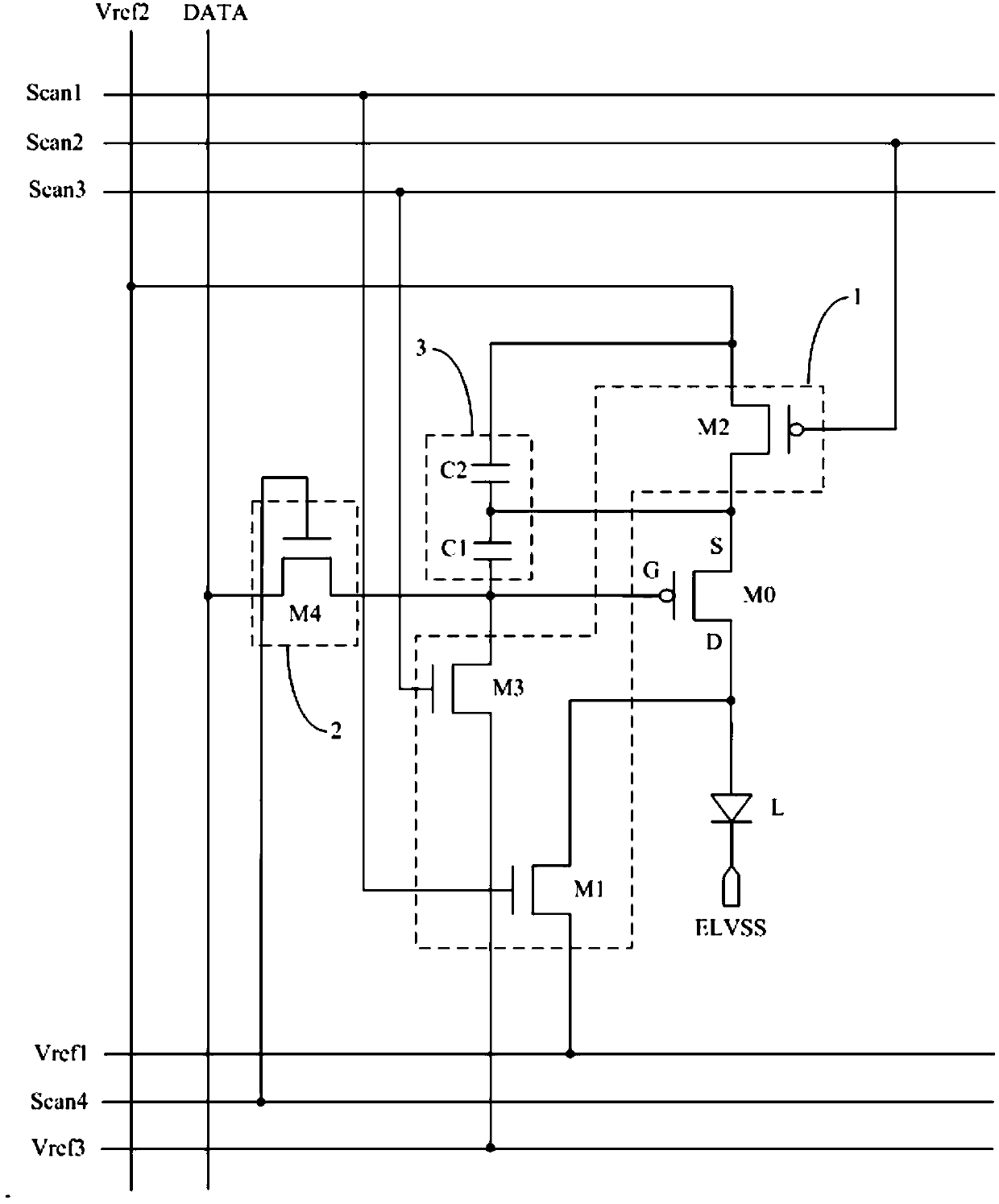Pixel circuit, driving method, electroluminescent display panel and display device
A technology of pixel circuits and light-emitting devices, applied in static indicators, instruments, etc., can solve problems such as inconsistent brightness
- Summary
- Abstract
- Description
- Claims
- Application Information
AI Technical Summary
Problems solved by technology
Method used
Image
Examples
Embodiment 1
[0132] by Figure 3b Take the pixel circuit shown as an example, and the corresponding input timing diagram is as follows Figure 5a shown. Specifically, the main selection of Figure 5a In the shown input timing diagram, there are three stages in total, namely, the reset stage T1, the data writing stage T2 and the light emitting stage T3.
[0133] In the reset phase T1, Scan1=1, Scan2=0, Scan4=0.
[0134] Since Scan1=1, both the first switch transistor M1 and the third switch transistor M3 are turned on. The turned-on first switch transistor M1 provides the signal of the first reference signal line Vref1 to the second pole D of the driving transistor M0, so as to reset the second pole D of the driving transistor M0 and the light emitting device L, so as to avoid two adjacent poles Luminous interference between display frames. . The turned-on third switch transistor M3 provides the signal of the first reference signal line Vref1 to the gate G of the driving transistor M0...
Embodiment 2
[0143] by Figure 3b Take the pixel circuit shown as an example to illustrate its working process, and the corresponding input timing diagram is as follows Figure 5b shown. Specifically, the main selection of Figure 5b There are four phases in the shown input timing diagram: reset phase T1, threshold compensation phase T2, data writing phase T3 and light emitting phase T4.
[0144] In the reset phase T1, Scan1=1, Scan2=0, Scan4=0.
[0145]Since Scan1=1, both the first switch transistor M1 and the third switch transistor M3 are turned on. The turned-on first switch transistor M1 provides the signal of the first reference signal line Vref1 to the second pole D of the driving transistor M0, so as to reset the second pole D of the driving transistor M0 and the light emitting device L, so as to avoid two adjacent Luminous interference between display frames. The turned-on third switch transistor M3 provides the signal of the first reference signal line Vref1 to the gate G of...
Embodiment 3
[0154] by Figure 4a Take the pixel circuit shown as an example to illustrate its working process, and the corresponding input timing diagram is as follows Figure 5c shown. Specifically, the main selection of Figure 5c There are four phases in the shown input timing diagram: reset phase T1, threshold compensation phase T2, data writing phase T3 and light emitting phase T4.
[0155] In the reset phase T1, Scan1=1, Scan2=0, Scan3=0, Scan4=0, EM=0.
[0156] Since Scan1=1, the first switching transistor M1 is turned on and provides the signal of the first reference signal line Vref1 to the second pole D of the driving transistor M0 to reset the second pole D of the driving transistor M0 . Since Scan2=0, the second switching transistor M2 is turned on, and the signal of the second reference signal line Vref2 is provided to the first pole S of the driving transistor M0 to reset the first pole S of the driving transistor M0, and through The storage capacitor C1 stores the volta...
PUM
 Login to View More
Login to View More Abstract
Description
Claims
Application Information
 Login to View More
Login to View More - R&D
- Intellectual Property
- Life Sciences
- Materials
- Tech Scout
- Unparalleled Data Quality
- Higher Quality Content
- 60% Fewer Hallucinations
Browse by: Latest US Patents, China's latest patents, Technical Efficacy Thesaurus, Application Domain, Technology Topic, Popular Technical Reports.
© 2025 PatSnap. All rights reserved.Legal|Privacy policy|Modern Slavery Act Transparency Statement|Sitemap|About US| Contact US: help@patsnap.com



